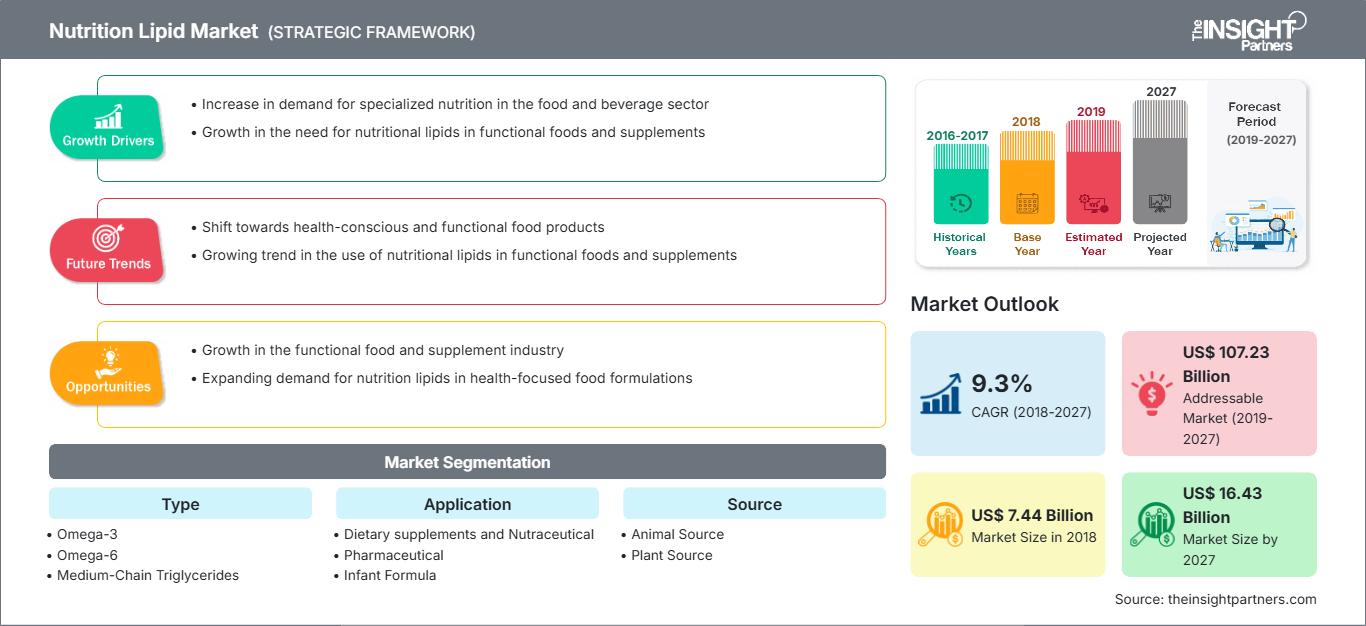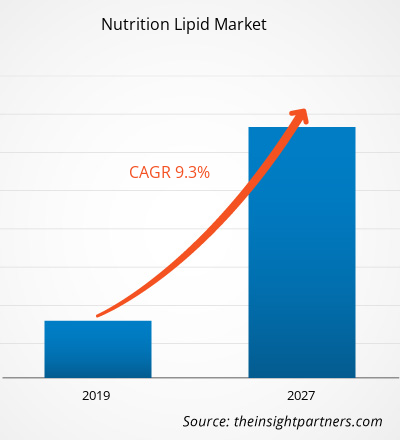[Forschungsbericht]Der globale Markt für Nahrungslipide belief sich 2018 auf 7.443,2 Mio. USD und soll im Prognosezeitraum 2019–2027 mit einer durchschnittlichen jährlichen Wachstumsrate von 9,3 % wachsen und bis 2027 16.429,6 Mio. USD erreichen.
Der asiatisch-pazifische Raum hatte den größten Marktanteil am globalen Markt für Nahrungslipide. Das Wachstum des Marktes für Nahrungslipide in dieser Region ist hauptsächlich auf die steigenden Ausgaben für nährstoffangereicherte funktionelle Lebensmittel und Nahrungsergänzungsmittel zurückzuführen. Darüber hinaus ist die Bedeutung von Nahrungslipiden in Säuglingsnahrung in der APAC-Region beispiellos und erzeugt daher eine beträchtliche Nachfrage nach Omega-3-Produkten. Das steigende Bewusstsein der Verbraucher für die Bedeutung und die gesundheitlichen Vorteile von Nahrungslipiden ist der Haupttreiber für das Wachstum des Marktes für Nahrungslipide in der Region. Dies wird das Wachstum des Marktes für Nahrungslipide im Prognosezeitraum beeinflussen. Darüber hinaus ist die steigende Kaufkraft der Verbraucher der Hauptfaktor, der den Akteuren des Marktes für Nahrungslipide lukrative Wachstumschancen bietet.
Passen Sie diesen Bericht Ihren Anforderungen an
Sie erhalten kostenlos Anpassungen an jedem Bericht, einschließlich Teilen dieses Berichts oder einer Analyse auf Länderebene, eines Excel-Datenpakets sowie tolle Angebote und Rabatte für Start-ups und Universitäten.
Markt für Ernährungslipide: Strategische Einblicke

-
Holen Sie sich die wichtigsten Markttrends aus diesem Bericht.Dieses KOSTENLOSE Beispiel umfasst Datenanalysen, die von Markttrends bis hin zu Schätzungen und Prognosen reichen.
Eine gesunde Ernährung schützt vor Unterernährung und nicht übertragbaren Krankheiten wie Herzkrankheiten, Diabetes und Krebs. Eine Salzaufnahme von weniger als 5 Gramm pro Tag trägt dazu bei, Bluthochdruck zu vermeiden und senkt das Risiko von Herzkrankheiten bei Erwachsenen. Die Mitgliedsstaaten der Weltgesundheitsorganisation (WHO) haben sich darauf geeinigt, den Salzkonsum der Weltbevölkerung bis 2025 um 30 % zu senken und den Anstieg von Diabetes und Fettleibigkeit bis 2025 zu stoppen. Nahrungsfette sind für einen gesunden Stoffwechsel und die Körperfunktionen wichtig und müssen in der täglichen Ernährung berücksichtigt werden. Nahrungsfette bestehen aus verschiedenen Fettarten mit spezifischen Vorteilen und Funktionen für den menschlichen Körper. Nahrungsfette werden aber auch in Tierfutter und Heimtiernahrung verwendet, um den Lipidgehalt von Nutztierprodukten zu erhöhen und die Gesundheit von Haustieren zu fördern. Der Markt für Nahrungsfette wird voraussichtlich aufgrund der ergänzenden Ernährung der städtischen Bevölkerung weltweit wachsen. Der Markt für Nahrungsfette entwickelt sich aufgrund des gestiegenen Bewusstseins der Verbraucher für die Vorteile einer gesunden Ernährung.
Wachsendes Bewusstsein in Schwellenländern bietet Chancen für Marktwachstum
Der Markt für Nahrungsfette entwickelt sich aufgrund des gestiegenen Bewusstseins der Verbraucher für die Vorteile einer gesunden Ernährung und der zunehmenden Gesundheitsbedenken. Die zunehmenden Innovationen, beispielsweise bei funktionellen Lebensmitteln, Arzneimitteln und Nahrungsergänzungsmitteln, schaffen Wachstumschancen für Nahrungsfette in Schwellenländern. Die wachsenden Märkte für Säuglings- und Frauennahrung in Schwellenregionen wie dem asiatisch-pazifischen Raum und Afrika. Die Liberalisierung ausländischer Direktinvestitionen im Lebensmittelsektor sind die Hauptfaktoren, die Chancen für den globalen Markt für Nahrungsfette schaffen. Darüber hinaus wird erwartet, dass die steigende Nachfrage nach Nahrungsergänzungsmitteln und funktionellen Lebensmitteln zusammen mit dem wachsenden verfügbaren Einkommen in Asien und Afrika das Wachstum des Marktes für Nahrungsfette im Prognosezeitraum ankurbeln wird. Auch die Nachfrage nach Omega-3-haltiger Säuglingsnahrung wächst in Schwellenregionen. Das Bewusstsein der Eltern für die Vorteile von Omega-3 für ein gesundes Säuglingswachstum wächst in diesen Regionen. Diese Faktoren tragen also dazu bei, Marktchancen zu schaffen.
Typ-Einblicke
Der globale Markt für Nahrungslipide wurde nach Typ segmentiert in Omega-3, Omega-6, mittelkettige Triglyceride und andere. Das Segment der Omega-3-Nahrungslipide dominiert den globalen Markt. Der Omega-3-Markt wird durch Faktoren wie ein steigendes Bewusstsein der Verbraucher für eine gesunde und ausgewogene Ernährung und deren gesundheitlichen Vorteile angetrieben. Außerdem senken Omega-3-Nahrungsergänzungsmittel wie EPA und DHA das Risiko von Dickdarm-, Prostata- und Brustkrebs. Eine ausreichende Menge EPA verringert das Risiko von Depressionen und anderen gesundheitlichen Problemen. Der Omega-3-Markt für Säuglingsanfangsnahrung verzeichnet in der abgepackten Lebensmittelindustrie aufgrund von Entwicklungen in asiatischen Ländern wie China eine hohe Wachstumsrate. Das Wachstum der weltweiten Omega-3-Produktion und die steigende Nachfrage danach sind die Hauptgründe für das stärkere Wachstum in allen Regionen.
Anwendungseinblicke
Auf Basis der Anwendung wurde der globale Markt für Nahrungslipide in Nahrungsmittel, Nahrungsergänzungsmittel und Nutraceuticals, Pharmazeutika, Säuglingsanfangsnahrung, Tiernahrung, Lebensmittelanreicherung und Sonstiges unterteilt. Unter den Anwendungssegmenten sind Nahrungsmittel, Nahrungsergänzungsmittel und Nutraceuticals das führende Segment auf dem globalen Markt für Nahrungslipide. Die wachsende Bedeutung der vorbeugenden Gesundheitsfürsorge hat die Verbraucher dazu gebracht, auf ihre tägliche Nährstoffaufnahme zu achten. Dies spiegelt sich deutlich in der Verwendung von Nahrungsergänzungsmitteln und Nutraceuticals auf der ganzen Welt wider. Nahrungsergänzungsmittel und Nutraceuticals können das Auftreten chronischer Krankheiten wie Arthritis, Asthma, Krebs, Diabetes usw. reduzieren oder verhindern. Da Nutraceutical-Produkte gesunde Inhaltsstoffe enthalten, steigt ihre Nachfrage, was zu einem erheblichen Anstieg in allen Regionen führt. Die wachsende Vorliebe der Verbraucher für proteinreiche Diäten mit natürlichen Zutaten treibt auch den globalen Markt für Nahrungsergänzungsmittel und Nutraceuticals an.
Fusionen und Übernahmen sowie Forschung und Entwicklung erwiesen sich als die am häufigsten angewandten Strategien auf dem globalen Markt für Nahrungslipide. Einige der jüngsten Entwicklungen auf dem globalen Markt für Nahrungslipide sind unten aufgeführt:
2017: Royal DSM und Evonik gründeten ein Joint Venture für Omega-3-Fettsäureprodukte aus natürlichen Meeresalgen für die Tierernährung. Diese Innovation ermöglicht die Produktion von Omega-3-Fettsäuren für die Tierernährung ohne die Verwendung von Fischöl aus wild gefangenem Fisch, einer endlichen Ressource.2017: Der Meeresfrüchtehersteller Cooke Inc. übernahm die Omega Protein Corporation, ein Unternehmen für Nahrungsprodukte, das mit Spezialölen und Spezialproteinprodukten handelt. Mit dieser Übernahme wollte das Unternehmen durch Diversifizierung der Angebotsseite des Geschäfts eine weitere Plattform in Cookes Wachstumsstrategie schaffen. 2018: BASF AS schloss in den USA eine randomisierte, placebokontrollierte klinische Studie ab, die kürzlich in Nutrients veröffentlicht wurde und die Verwendung von hochkonzentriertem Omega-3 zur Korrektur des ernährungsbedingten Mangels an Omega-3-Fettsäuren bei Patienten mit nichtalkoholischer Fettlebererkrankung (NAFLD) untersuchte.
Nutrition Lipid
Regionale Einblicke in den Markt für NahrungslipideDie Analysten von The Insight Partners haben die regionalen Trends und Faktoren, die den Markt für Nahrungslipide im Prognosezeitraum beeinflussen, ausführlich erläutert. In diesem Abschnitt werden auch die Marktsegmente und die geografische Lage von Nahrungslipiden in Nordamerika, Europa, Asien-Pazifik, dem Nahen Osten und Afrika sowie Süd- und Mittelamerika erörtert.
Umfang des Marktberichts zu Nahrungslipiden
| Berichtsattribut | Einzelheiten |
|---|---|
| Marktgröße in 2018 | US$ 7.44 Billion |
| Marktgröße nach 2027 | US$ 16.43 Billion |
| Globale CAGR (2018 - 2027) | 9.3% |
| Historische Daten | 2016-2017 |
| Prognosezeitraum | 2019-2027 |
| Abgedeckte Segmente |
By Typ
|
| Abgedeckte Regionen und Länder |
Nordamerika
|
| Marktführer und wichtige Unternehmensprofile |
|
Dichte der Marktteilnehmer für Nahrungslipide: Verständnis ihrer Auswirkungen auf die Geschäftsdynamik
Der Markt für Nahrungslipide wächst rasant. Die steigende Nachfrage der Endverbraucher ist auf Faktoren wie veränderte Verbraucherpräferenzen, technologische Fortschritte und ein stärkeres Bewusstsein für die Produktvorteile zurückzuführen. Mit der steigenden Nachfrage erweitern Unternehmen ihr Angebot, entwickeln Innovationen, um den Bedürfnissen der Verbraucher gerecht zu werden, und nutzen neue Trends, was das Marktwachstum weiter ankurbelt.

- Holen Sie sich die Markt für Ernährungslipide Übersicht der wichtigsten Akteure
GLOBALE MARKTSEGMENTIERUNG FÜR ERNÄHRUNGSLIPIDE
Nach Typ
Nach Anwendung
Nach Quelle
Nach Form
Nach Geografie
-
Nordamerika
- USA
- Kanada
- Mexiko
-
Europa
- Frankreich
- Deutschland
- Italien
- Vereinigtes Königreich
- Russland
- Rest von Europa
-
Asien-Pazifik
- China
- Japan
- Südkorea
- Indien
- Australien
- Übriger Asien-Pazifik
-
Naher Osten und Afrika (MEA)
- VAE
- Saudi-Arabien
- Süden Afrika
- Rest von MEA
-
Südamerika
- Brasilien
- Argentinien
- Rest von Südamerika (SAM)
Firmenprofile
- Archer Daniels Midland Company
- BASF SE
- Croda International Plc
- Koninklijke DSM NV
- Neptune wellness solutions Inc
- Nordic Naturals, Inc.
- Omega Protein Corporation
- Pelagia AS
- Pharma Marine AS
- Polaris
- Historische Analyse (2 Jahre), Basisjahr, Prognose (7 Jahre) mit CAGR
- PEST- und SWOT-Analyse
- Marktgröße Wert/Volumen – Global, Regional, Land
- Branchen- und Wettbewerbslandschaft
- Excel-Datensatz
Aktuelle Berichte
Erfahrungsberichte
Grund zum Kauf
- Fundierte Entscheidungsfindung
- Marktdynamik verstehen
- Wettbewerbsanalyse
- Kundeneinblicke
- Marktprognosen
- Risikominimierung
- Strategische Planung
- Investitionsbegründung
- Identifizierung neuer Märkte
- Verbesserung von Marketingstrategien
- Steigerung der Betriebseffizienz
- Anpassung an regulatorische Trends






















 Kostenlose Probe anfordern für - Markt für Ernährungslipide
Kostenlose Probe anfordern für - Markt für Ernährungslipide